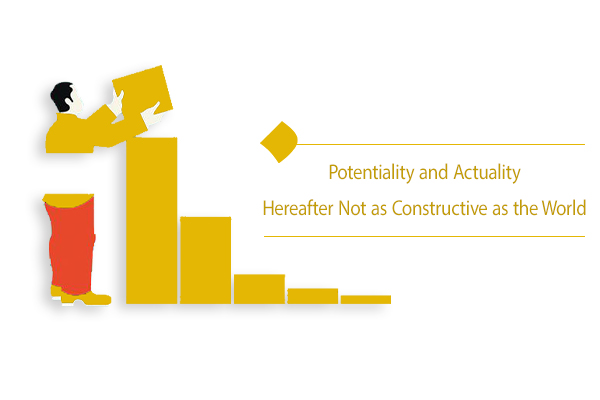The Proportion Between the World and the Hereafter Is the Proportion of Potentiality and Actuality.
Have you ever heard of fetal surgery in the mother’s womb? Why do doctors prefer to treat many fetal diseases and defects in the mother’s womb? Why do they not wait for the baby to be born, and then perform medical treatments? The answer is very simple. Some inborn disorders and diseases of the fetus are either not basically treatable after birth, or their treatment demands considerable cost and unbearable pain. For this reason, doctors emphasize treating such diseases before birth and in the womb, so that the fetus’s body can use the extraordinary power of the womb for the rapid reconstruction of damaged tissues.
But why is it like this? Why can the womb, which is small and has no advanced resources, quickly cure the defects, while the world, with all its advancement and grandeur, cannot? The answer lies in the proportion between the mother’s womb and the world. The proportion between the mother’s womb and the world is the proportion of potentiality and actuality. A fertilized egg cell in the womb transforms into a complete human being in just nine months. Whereas if this same human being loses a phalanx of her finger during childhood, even if she lives ninety years, the world cannot fix this small defect and grow a new one for her. This means that the mother’s womb possesses a power and potential that the world lacks. In other words, compared to the womb, the world has greater actuality but limited constructive potentiality.
The proportion of potentiality and actuality is another aspect of the Law of Proportion. Understanding this concept brings us one step closer to understanding the characteristics of the hereafter. Therefore, in this lesson, we will first explain the concepts of potentiality and actuality, and then we will examine these concepts in the proportion between the world and the hereafter.
What Does Potentiality and Actuality Mean?
Change and transformation are one of the most obvious and undeniable truths of the world. The world is not stagnant, static, or solid. Phenomena in the world are constantly changing, with objects shifting from one state, condition, or quality to another. But these transformations are not haphazard; it means that not everything can be transformed into something else. Rather, the transformation requires innate capability and potential. For instance, a wheat seed only has the potential to transform into a wheat stalk and can never become corn; similarly, a twenty-centimeter piece of cloth only has the potential to become a baby bib, a small napkin, and the like, and it can never turn into a suit. We call this innate ability, which has not flourished yet, “potentiality.” Therefore, a wheat seed is potentially a wheat stalk, and a twenty-centimeter piece of cloth is potentially a bib or a small napkin.
The opposite of potentiality is “actuality.” What does actuality mean? The term actuality is used when the inner potential of a being comes out of its state of potentiality and reaches its full realization. To understand the concept of actuality, consider an egg. This egg can transform into a chick in twenty-one days. This means that the egg has the ability and potentiality to transform the embryo inside it into a complete chick in twenty-one days. When the embryo inside the egg transforms into a chick, the egg has transitioned from potentiality to actuality. In other words, potentiality manifests itself in the egg, while actuality is manifest in the chick. Similarly, in the examples above, potentiality lies in the wheat seed, while actuality exists in the wheat stalk; likewise, potentiality resides in the cloth, while actuality is in the bib.
Another point about the concept of potentiality and actuality is that once something transitions from potentiality to actuality, it cannot go back and transform into potentiality. For instance, a chick cannot revert to its embryonic stage, and a wheat stalk cannot return to its seed state. This aspect is highly crucial in the relation between the mother’s womb and the world, as well as the relation between the world and the hereafter.
Comparing the World and the Hereafter in Terms of Potentiality and Actuality
We mentioned that the proportion between the mother’s womb and the world is the proportion of potentiality and actuality, meaning that potentiality manifests itself in the womb and actuality in the world. So when the stages of fetal development in the mother’s womb end and the baby enters the world, he can no longer easily fix disorders and problems as he could in the womb. This is because he has transitioned from potentiality to actuality. The world is the realm of actuality, and its constructive capability is very limited compared to the womb. Therefore, it cannot easily compensate for inborn defects and problems. Of course, the world does not intend to harm the fetus, and in fact, all the resources of the world are designed for the benefit, pleasure, and comfort of the fetus. However, the main condition for benefiting from these resources is to have a completely healthy body. A fetus that wastes his time in the womb and neglects organ development will inevitably be born with physical disorders or diseases.
The proportion of potentiality and actuality also applies to the world and the hereafter. The hereafter is the realm of actuality, while the world is the realm of potentiality. That is why if we do not overcome our sins, spiritual impurities, and moral weaknesses in the world, and depart from this world in the same state, we will face many difficulties after death. We must spend centuries in the hell of Barzakh and endure the suffering of purification until these impurities are cleansed from our souls. This is while we do not know how many years in the world equal one century in Barzakh. All the diseases and weaknesses of the soul, such as greed, envy, arrogance, etc., are treatable in the womb of the world with a little self- scrutiny and hard work. Even if someone has made mistakes throughout her entire life, as long as she is alive, she can make up for all her sins and mistakes in just one night. This extraordinary capacity is exclusive to the world, and the hereafter, with all its grandeur and vastness, lacks such a possibility.
Of course, it is necessary to mention one of the differences between the mother’s womb and the womb of the world. The fetus in the mother’s womb has no free will, and her growth and development are carried out through what the world plans and the intervention of the unseen. But the human being has free will in the womb of the world, and as a result, she will be responsible for what she acquires.
In the next lessons, we will further discuss the different types of birth into Barzakh and the various types of hell. If you have any questions or doubts about the current topic, i.e., the proportion of potentiality and actuality, please share them with us in the comments section.

